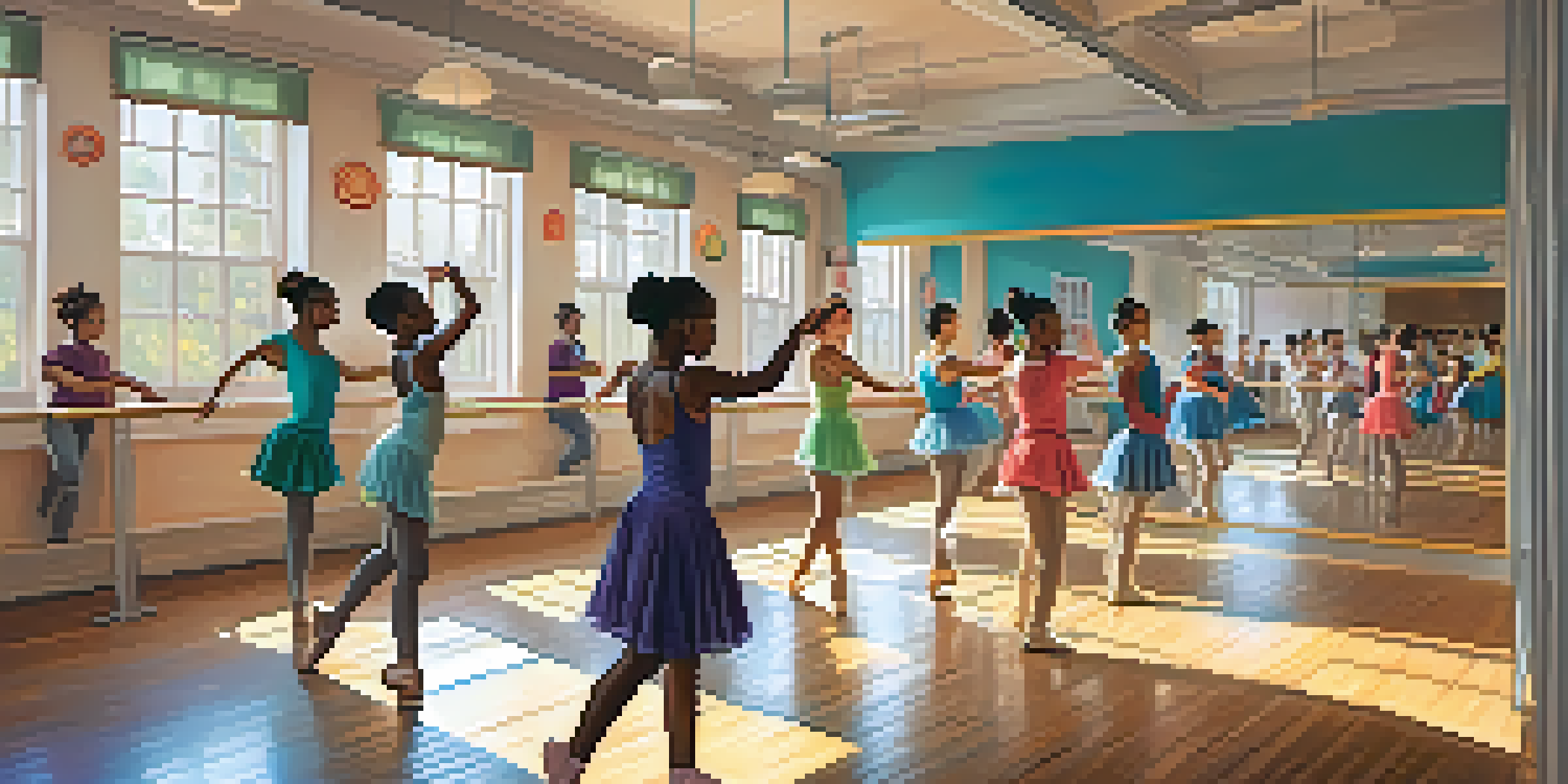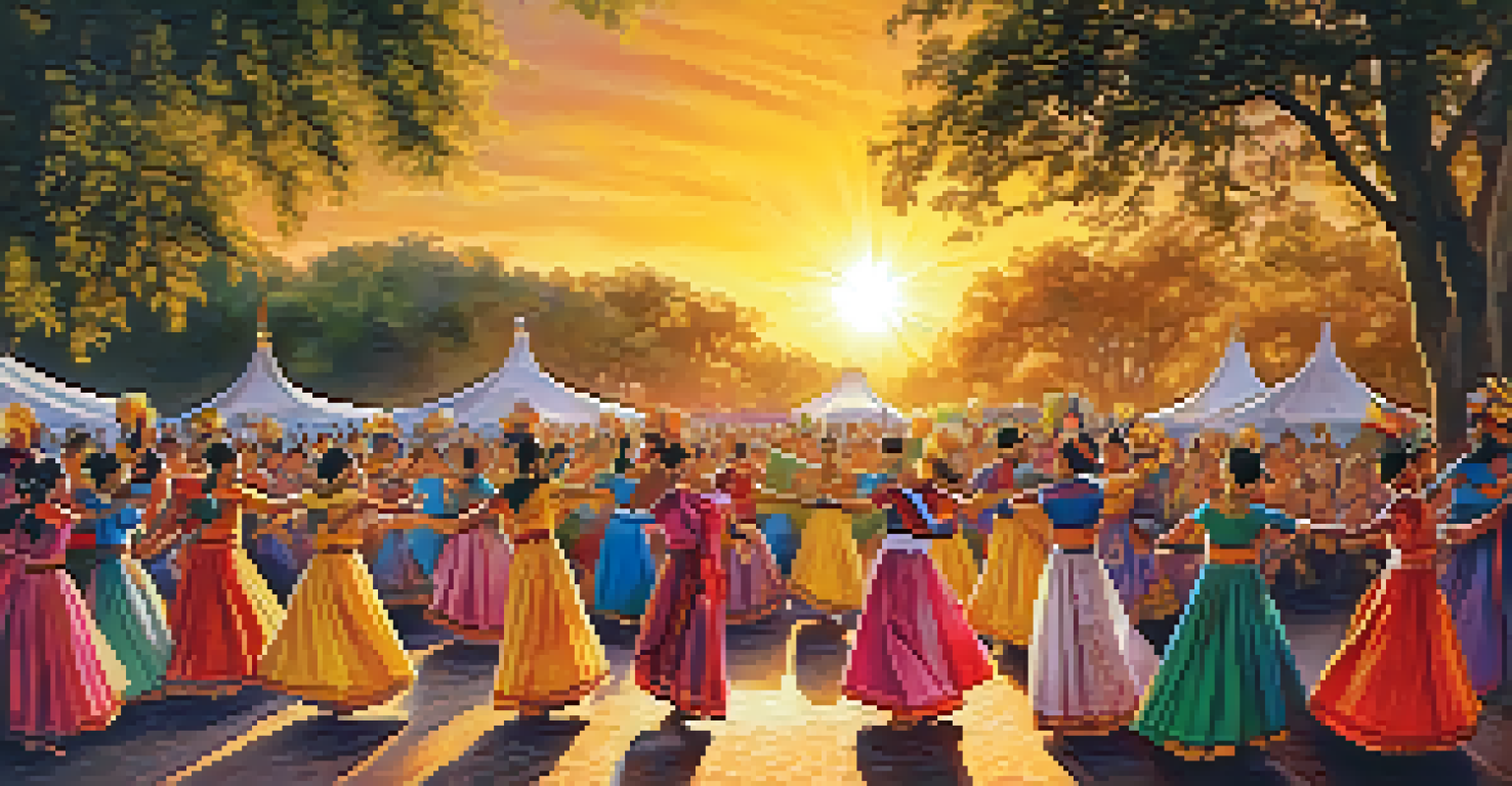The Historical Perspective of Dance in Education Systems

The Origins of Dance in Education: A Cultural Insight
Dance has been an integral part of human culture for centuries, dating back to ancient civilizations. In societies like Egypt and Greece, dance was often linked to religious rituals and communal celebrations, serving as a way to express cultural values. These early forms of dance laid the groundwork for its eventual inclusion in educational settings, emphasizing the importance of movement in human expression.
Dance is the hidden language of the soul.
As education systems began to formalize, particularly during the Renaissance, dance started to be incorporated into curricula. Schools recognized the value of dance not only as an art form but also as a means to develop discipline, coordination, and social skills among students. This shift marked the beginning of dance's recognition as an essential component of a well-rounded education.
By the 19th century, dance education began to take on a more structured form, with institutions establishing dedicated programs. These programs aimed to formalize dance training and introduced students to various styles, from ballet to folk dance, showcasing dance's multifaceted nature. This period marked a significant evolution in how dance was perceived within educational frameworks.
The Impact of Dance on Child Development
Research has shown that dance contributes significantly to a child's physical, emotional, and cognitive development. Engaging in dance helps improve motor skills, encourages creativity, and fosters a sense of teamwork and collaboration. These benefits highlight why many educators advocate for dance programs in schools.

Moreover, dance can serve as an emotional outlet for students, providing them with a means to express feelings that may be difficult to articulate. This aspect is particularly valuable in inclusive education settings, where students from various backgrounds come together. Dance creates a shared experience, promoting empathy and understanding among peers.
Dance Enhances Child Development
Engaging in dance improves children's physical, emotional, and cognitive skills, making it a vital educational tool.
Cognitive benefits are also noteworthy; studies suggest that learning dance routines can enhance memory and concentration. When students engage in dance, they are not only exercising their bodies but also their minds, leading to improved academic performance. This connection reinforces the notion that dance is not just a physical activity but a holistic educational tool.
Dance Education in the 20th Century: Expanding Horizons
The 20th century marked a transformative period for dance in education, with the introduction of diverse styles and techniques. Dance education evolved from a focus on classical ballet to embrace modern dance, jazz, and even hip-hop, reflecting the changing cultural landscape. This expansion allowed students to explore various forms of expression and discover their unique styles.
To watch us dance is to hear our hearts speak.
During this time, influential figures in the dance community pushed for greater inclusion of dance in school curricula. Educators began to recognize dance as a legitimate subject worthy of academic study, leading to the establishment of dance degrees at universities. This shift not only validated dance as an art form but also encouraged a generation of students to pursue careers in the field.
As dance education gained traction, various organizations emerged to support teachers and advocate for dance in schools. These initiatives have played a crucial role in ensuring that dance remains a vibrant part of the education system, inspiring students to pursue their passion for movement and creativity.
The Role of Technology in Dance Education Today
In today's digital age, technology plays a pivotal role in how dance is taught and experienced. Online platforms have made it easier for students to access dance classes and tutorials, breaking geographical barriers. This accessibility has democratized dance education, allowing a wider range of students to explore their interests.
Furthermore, technology enhances the learning experience through the use of video analysis and feedback tools. Teachers can record students' performances, providing them with constructive critiques that help refine their skills. This immediate feedback loop fosters a more interactive and engaging learning environment, transforming traditional dance education methods.
Technology Transforms Dance Education
The use of technology in dance education provides greater accessibility and enhances learning through interactive feedback.
Social media has also contributed to the evolution of dance education, as students showcase their progress and connect with peers globally. Dance challenges and trends can inspire students to participate and innovate, creating a sense of community. This blend of technology and dance education not only enriches learning but also prepares students for a future where digital skills are paramount.
Advocating for Dance in School Curricula
Despite its benefits, dance education often faces challenges in gaining recognition within school curricula. Advocates argue that dance should be prioritized alongside traditional subjects like math and science, as it contributes to a well-rounded education. Schools that embrace dance often see enhanced student engagement and improved overall well-being.
To promote dance education, it is essential for educators, parents, and community members to collaborate and advocate for funding and resources. This collective effort can lead to the establishment of dance programs that are accessible to all students, regardless of their background. By fostering a supportive environment, schools can cultivate a culture where dance thrives.
Additionally, showcasing the achievements of students in dance can help raise awareness and appreciation for the art form. Dance performances, competitions, and community events can highlight the positive impact of dance education, encouraging more schools to integrate these programs into their offerings. Celebrating student success in dance can inspire future generations to engage with this expressive art form.
Dance as a Tool for Cultural Understanding
Dance is a powerful medium for fostering cultural understanding and appreciation in educational settings. By learning about various dance styles from around the world, students gain insight into different cultures and traditions. This exposure not only broadens their perspectives but also promotes inclusivity and respect for diversity.
Incorporating global dance forms into curricula enables students to explore the historical and social contexts of these art forms. For example, learning traditional dances from Indigenous cultures can spark conversations about history and heritage, enriching the educational experience. This understanding cultivates empathy and helps students recognize the interconnectedness of different cultures.
Advocacy for Dance in Schools
Promoting dance education requires collaboration among educators, parents, and communities to secure funding and resources.
Moreover, cultural dance exchanges and collaborations can enhance the learning experience, allowing students to engage directly with diverse communities. These interactions can lead to meaningful friendships and shared experiences, fostering a sense of unity. Ultimately, dance serves as a bridge, connecting students to one another and to the rich tapestry of global cultures.
The Future of Dance in Education: Trends and Innovations
As we look towards the future, the integration of dance in education is likely to continue evolving. Emerging trends, such as interdisciplinary approaches that combine dance with subjects like science and technology, are gaining traction. These innovative methods can make learning more engaging and relevant for students in a rapidly changing world.
Moreover, the rise of virtual reality (VR) and augmented reality (AR) technologies presents exciting possibilities for dance education. These tools can create immersive experiences, allowing students to explore dance in new and interactive ways. Imagine students being able to participate in a virtual dance class with instructors from around the globe, breaking down geographical barriers.

Ultimately, the future of dance in education hinges on the continued advocacy for its inclusion and the creativity of educators in designing engaging programs. By embracing new technologies and innovative teaching methods, schools can ensure that dance remains a vibrant and essential part of the educational landscape. The journey of dance in education is far from over, and its potential is limitless.